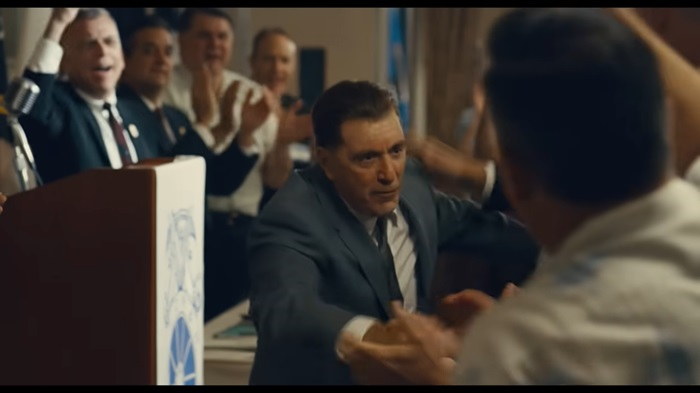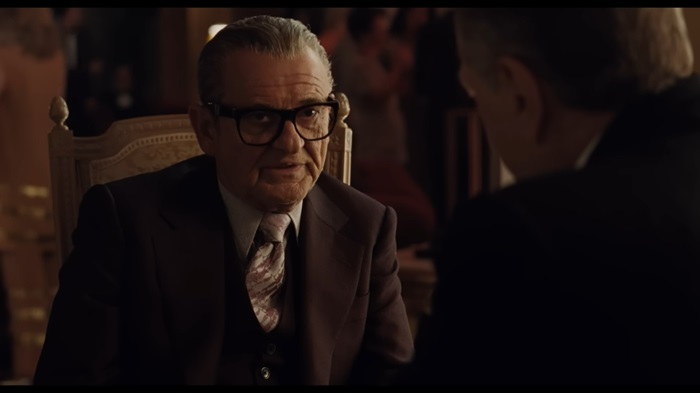The Irishman is a 2019 epic crime film directed by Martin Scorsese. The film, based on the 2004 book I Heard You Paint Houses" by Charles Brandt, spans several decades and delves into the life of Frank Sheeran, a mob hitman, and his involvement with organized crime, particularly his association with Jimmy Hoffa. With a star-studded cast including Robert De Niro, Al Pacino, and Joe Pesci, The Irishman explores themes of loyalty, power, and the consequences of a life of crime.
Plot Summary
The narrative of The Irishman is framed by the reflections of Frank Sheeran (Robert De Niro), an elderly man confined to a wheelchair, as he recounts his life story. The film begins in the 1950s when Frank, a truck driver, gets involved with the Philadelphia crime family led by Russell Bufalino (Joe Pesci). Russell recognizes Frank's loyalty and ruthlessness, leading to his induction into the world of organized crime.
Frank's journey intertwines with key historical events and figures, most notably his relationship with Teamsters Union leader Jimmy Hoffa (Al Pacino). As Frank rises in the ranks of the mob, he becomes a trusted ally of both Russell and Hoffa, blurring the lines between business, friendship, and betrayal.
The film meticulously depicts Frank's progression from a loyal soldier to a feared hitman. His involvement in criminal activities, including assassinations and body disposal (painting houses is a euphemism for murder), becomes increasingly central to the narrative. The plot explores the inner workings of the mob, the dynamics between different crime families, and the impact of their actions on American history.
The friendship between Frank and Jimmy Hoffa is a focal point of the story. Hoffa, a charismatic and powerful union leader, seeks Frank's support as tensions rise within the Teamsters and conflicts arise with other mob factions. The film explores the complexities of their relationship, depicting moments of camaraderie, trust, and, ultimately, the strains that lead to a tragic falling out.
As the years pass, the characters age, and the consequences of a life steeped in violence and crime become more apparent. The film employs groundbreaking digital de-aging technology to portray the characters at various stages of their lives, allowing the audience to witness decades of events unfold with the same actors.
The Ending Explained

The climax of The Irishman is marked by the deteriorating relationship between Frank Sheeran and Jimmy Hoffa. Hoffa's growing defiance and refusal to yield to the mob's control become a source of concern for the crime families. Frank, torn between loyalty to his friend and loyalty to the mob, finds himself in an impossible position.
The tension escalates as the film builds towards the inevitable collision between Hoffa and the forces that seek to bring him under control. The climax is a culmination of years of build-up, with the audience aware that the choices made by these characters will have profound and irreversible consequences.
In a fateful meeting at the Machus Red Fox restaurant in Detroit, Hoffa is confronted by mob associates, including Frank. The atmosphere is tense, and the weight of the impending tragedy hangs in the air. The scene unfolds with a mix of suspense and inevitability, capturing the complexity of the relationship between these two powerful figures.
The Irishman's ending is a poignant reflection on the cost of a life immersed in crime. As the story draws to a close, the elderly Frank, haunted by his actions and the choices he made, grapples with the loneliness and isolation that come with a lifetime of betrayals and violence. The consequences of his decisions reverberate through the years, impacting not only his own life but the lives of those around him.

The central theme of the ending revolves around Frank's solitude and the impact of his actions on his relationships. He has outlived most of his contemporaries, including Russell Bufalino (Joe Pesci) and Jimmy Hoffa (Al Pacino), and now faces the solitude of old age. The film explores the loneliness that comes with a life marked by violence, betrayal, and the erosion of personal connections.
As Frank reflects on his life, the film takes us back to the events that led to Hoffa's disappearance. Without going into every detail, it is revealed that Frank played a crucial role in Hoffa's demise. The film suggests that Hoffa's fate was inevitable, given the complex web of alliances, betrayals, and power struggles within the organized crime syndicate.
The ending of The Irishman serves as a fitting conclusion to the narrative, offering a reflection on the choices made by the characters and the enduring impact of a life lived in the shadows of organized crime. The film's epic scope, coupled with the stellar performances of its cast, contributes to its status as a cinematic achievement.
The final scenes are quiet and contemplative. Frank is left to grapple with the consequences of his actions, and the film doesn't offer easy redemption or resolution. The closing moments emphasize the cyclical nature of violence and the inescapable loneliness that accompanies a life devoted to crime.
The narrative circles back to Frank in the nursing home, where he reflects on the passing of time and the choices that defined his life. The film concludes with a door closing—a symbolic representation of the finality of Frank's story and the isolation he now faces.
The Irishman provides a sombre and reflective ending, eschewing traditional Hollywood resolutions for a more nuanced exploration of the human cost of a life immersed in crime. The closing scenes capture the essence of the film's themes—regret, the passage of time, and the toll that loyalty to organized crime exacts on one's soul.






